Six reasons Bradford deserved to win UK City of Culture 2025 - what makes the West Yorkshire city so special?
Following a bid by Bradford 2025, Bradford Metropolitan District Council and the University of Bradford to compete for the UK City of Culture 2025 title - it was revealed yesterday (May 31) that Bradford won.
The UK City of Culture title is awarded every four years by the government and the winner gets to host a year-long programme of cultural events, activities and celebrations.
Advertisement
Hide AdAdvertisement
Hide AdBradford’s big news left Bradford locals ecstatic; celebrating into the night with coloured smoke bombs, patriotic chants with a festival-like atmosphere that filled the air.


The city in West Yorkshire will be taking over from Coventry which has held the title since 2021.
The winner of UK City of Culture can look forward to more than 1,000 performances and events across the year celebrating Bradford’s heritage and culture, featuring work from 365 artists.
This title could also bring an extra £700 million of investment to the district, which in turn could create around 3,000 jobs and bring in 1.1 million visitors.
Advertisement
Hide AdAdvertisement
Hide AdChair of Bradford 2025, Shanaz Gulzar, said: “This is a huge opportunity to celebrate our extraordinary cultural heritage and for our young, ethnically diverse population - who have been so involved in shaping our bid - to become leaders and changemakers and begin a new chapter in our story.


“Bradford has been overlooked and underestimated for so long - it’s now our time to shine.”
So let’s take a look back at what makes Bradford worthy of the UK City of Culture 2025 title.
Arts and culture
Bradford is the first UNESCO City of Film in the world, with the National Science and Media Museum having been the UK’s biggest tourist attraction, delving into photography, broadcast media and the internet.


Advertisement
Hide AdAdvertisement
Hide AdFood is at the heart of Yorkshire which prides itself on natural, organic ingredients. The UK City of Culture is not the only award Bradford has received, as the city has been crowned Curry Capital of Britain for the last five years in a row.
Bradford has also been the birthplace of many famous faces who have impacted the culture and arts industry including singer Zayn Malik, formerly of One Direction, magician Steven Frayne, better known as Dynamo, Ricky Wilson, frontman of the Kaiser Chiefs and Tom Cleverly whose career took off as a Midfielder for Manchester United and the England International Football teams.
Historical landmarks
Bradford’s famous landmarks include Bolling Hall, one of the oldest buildings in the city which dates back to the 14th century and by 1316 it was owned by William Bolling.
Another significant landmark that made a splash in history is Cartwright Hall, the civic art gallery which was first opened in 1904 with a collection of Victorian and Edwardian artworks donated by Samuel Lister.
Advertisement
Hide AdAdvertisement
Hide AdBradford is well known for its silk manufacturing history, which was first introduced in Lister’s Mill, which was the largest silk factory in the world. It was built in the 19th century before it was destroyed by a fire in 1871 and rebuilt. It is a Grade II listed building and in its heyday it employed 11,000 men, women and children.
Historical figures
There have been many prominent figures in history who have made a significant impact on the world who hailed from Bradford.
Sir Edward Victor Appleton was a physicist, Nobel Prize winner (1947) and pioneer in radiophysics. He studied at Bradford College from 1909 to 1911 and his seminal work proving the existence of the ionosphere during experiments carried out in 1924 won him the Nobel Prize in Physics.
Barbara Jane Harrison was a flight attendant who was posthumously awarded the George Cross for her role in the evacuation of British Overseas Airways Corporation (BOAC) Flight 712; she is one of four women to have been awarded the George Cross for heroism.
The Bronte sisters
Advertisement
Hide AdAdvertisement
Hide AdThe three sisters, Charlotte, Emily and Anne Bronte, are famous poets and novelists who were born in Haworth, which is situated in the City of Bradford district. They originally published their poems and books under male pseudonyms: Currer, Ellis and Acton Bell.
Their novels were an immediate success for their passion and originality, with Charlotte’s Jane Eyre taking off first, while Emily’s Wuthering Heights and Anne’s The Tenant of Wildfell Hall were considered masterpieces of literature.
A writer’s house museum, Bronte Parsonage Museum, was built between 1778 and 1779 and maintained by the Bronte Society in honour of the Bronte sisters. It is located in the home previously occupied by the Bronte family in Haworth, where the sisters spent their childhood and wrote their famous books.
The parsonage is a Grade I listed building on the National Heritage List for England.
In popular culture
Advertisement
Hide AdAdvertisement
Hide AdThe city has been the location for film and TV including The Railway Children (1970), Yanks (1979) starring Richard Gere, Monty Python’s The Meaning of Life (1983) partly filmed in Lister Park, a Channel 4 documentary called Make Bradford British which analysed the level of integration between the city’s Christian and Muslim communities, Kay Mellor’s The Syndicate (2013) and of course the popular All Creatures Great and Small.
Film and TV is one of Yorkshire’s most attractive reasons for its high tourism rate, along with its stunning landscapes and vibrant cityscapes.
The Industrial Revolution
Bradford’s entire population was made up of just 6,393 people in 1801, where wool spinning and cloth weaving was carried out in local cottages and farms.
The size of the now vibrant city was smaller than Huddersfield (7,268) and particularly smaller than Halifax (8,866) and the small town acted as a hub for three towns: Manningham, Bowling and Great and Little Horton.
Advertisement
Hide AdAdvertisement
Hide AdThanks to the introduction of blast furnaces in 1788 and iron usage and the expansion of Bradford in 1847 when 46 coal mines were introduced, Bradford’s population grew significantly to 34,560 in 1841.
The wool-combers union called a strike in 1825 for five months, but workers were forced to resume working through hardship resulting in machine-combing. This Industrial Revolution led to rapid growth, with wool being imported in large quantities and Bradford became known as the ‘wool capital of the world’.
Comment Guidelines
National World encourages reader discussion on our stories. User feedback, insights and back-and-forth exchanges add a rich layer of context to reporting. Please review our Community Guidelines before commenting.
